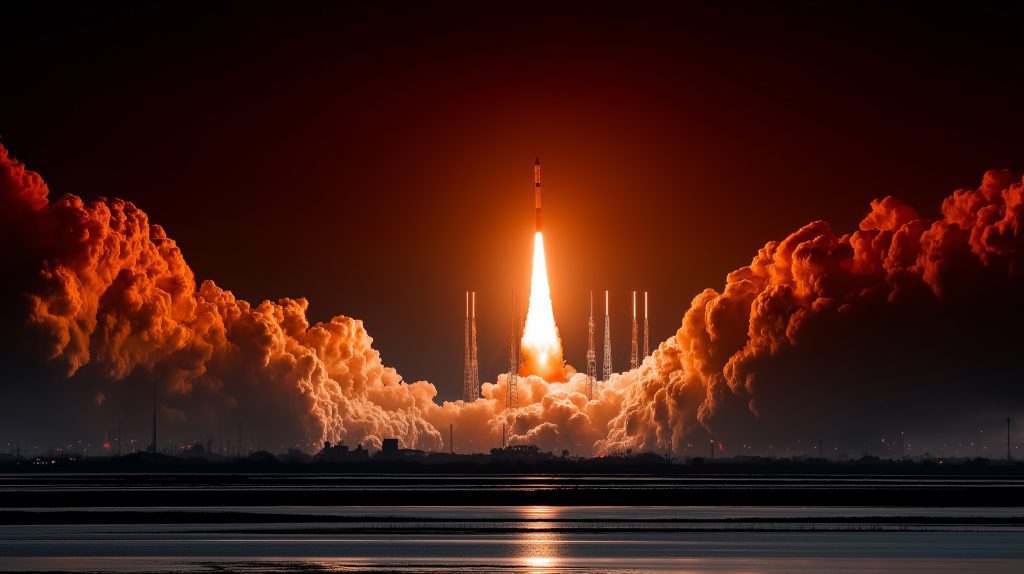- The China National Space Administration (CNSA) was established in 1993 as China’s civil space authority.
- By the end of 2024, China operated more than 1,060 active satellites in orbit, a count that has grown more than six-fold since 2015.
- Chang’e-4 achieved the first landing on the Moon’s far side in 2019.
- Micius (Mozi), launched in 2016, became the world’s first quantum communications satellite enabling space-based quantum key distribution.
- BeiDou reached full global coverage with the final BDS-3 satellite launched in June 2020.
- The Guowang LEO megaconstellation targets about 13,000 satellites, with three batches launched by April 2025 and an initial 648-satellite goal for 2025.
- The Tiangong space station was completed in late 2022, comprising the Tianhe core module and the Wentian and Mengtian lab modules and hosting rotating crews of three taikonauts.
- Tianwen-1 reached Mars in 2021, delivering the Zhurong rover.
- Xuntian Space Telescope is planned to launch around 2024–2025 to co-orbit with Tiangong, featuring a 2.5 gigapixel camera and a field of view 300 times that of Hubble.
- China’s space-solar-power roadmap, from 2028 to 2050, envisions a 10 kW test satellite in 2028, 1 MW in 2030, 10 MW in 2035, and about 2 GW on Earth by 2050.
China’s space program has rapidly transformed into a space empire of global scale, guided by the China National Space Administration (CNSA). In just a few decades, China went from launching its first satellite in 1970 to operating a fleet of over 1,000 satellites and a fully crewed space station in orbit [1] [2]. Today, China conducts one of the world’s most active launch schedules, rivaling or surpassing other space powers with dozens of missions each year [3]. This report dives deep inside China’s space empire – outlining CNSA’s mission and history, surveying Chinese satellite categories and services, detailing launch capabilities, and exploring future plans from the Moon to Mars and beyond.
Overview of China’s Space Program and CNSA
Established in 1993, the China National Space Administration (CNSA) is the government agency responsible for China’s civil space activities and international cooperation [4]. CNSA provides overall policy direction and diplomatic outreach, while actual missions are executed by state-owned enterprises – notably the China Aerospace Science and Technology Corporation (CASC) – and by specialized program offices [5]. (For example, China’s human spaceflight endeavors are managed by the China Manned Space Agency under the military, not directly by CNSA [6].) This structure reflects the unique civil-military blend of China’s space program: civilian agencies handle administration and foreign liaisons, while military branches oversee launch and satellite operations. In fact, until 2024 the People’s Liberation Army Strategic Support Force (PLASSF) managed much of China’s space infrastructure – from reconnaissance satellites to the Beidou navigation system – before a recent reorganization created a dedicated PLA Aerospace Force [7] [8].
Mission and Vision: China’s space effort serves both scientific development and national strategy. CNSA’s mission emphasizes exploring outer space to advance humanity’s understanding, while also boosting China’s national prestige and security [9] [10]. President Xi Jinping has declared space a critical frontier for the “China Dream” of national rejuvenation [11]. Accordingly, China pursues a full spectrum program: satellite applications, human spaceflight, and deep-space exploration. The results are evident in a string of achievements – first Chinese crewed spaceflight in 2003, an orbital docking and space lab by 2011, a robotic Moon rover landing in 2013, and a permanent modular space station by 2022 [12]. CNSA also notched historic firsts like being the first to land on the Moon’s far side (Chang’e-4 in 2019) and the second agency to land on Mars (Tianwen-1 rover in 2021) [13]. These milestones highlight the “secret power” of CNSA – a fast-learning organization leveraging centralized coordination, ample funding, and strategic patience to catch up with longer-established agencies.
Scale and Budget: In recent years, China’s space program has grown explosively. Since 2015, China’s on-orbit satellite count has expanded over six-fold, reaching more than 1,060 active satellites by the end of 2024 [14]. Only the United States operates more satellites, and China’s fleet spans communications, navigation, Earth observation, weather, and scientific missions (many with dual civilian-military roles) [15]. China’s annual launch rate now consistently ranks #1 or #2 globally, supported by four major spaceports on its soil [16]. In 2024, for example, China conducted 68 orbital launches, deploying 260 spacecraft (a national record) [17]. The CNSA’s budget has likewise expanded, reaching an estimated $18+ billion USD in 2023, second only to NASA’s budget and ahead of Europe’s [18]. This robust funding underpins projects from satellite mega-constellations to interplanetary probes. In short, China has rapidly built a comprehensive space program that now rivals the traditional space superpowers in scope and ambition.
Chinese Satellites: Categories and Notable Systems
China operates a vast array of satellites serving diverse purposes. These can be grouped into several main categories, each comprising notable satellite series and constellations:
- Communication Satellites: China has an extensive lineup of geostationary communication satellites under names like ChinaSat (Zhongxing) and ApStar, delivering television, radio, and broadband services across Asia and beyond. The first Chinese communications sat, Dongfanghong-1 (launched in 1970), was a technology demonstrator that beamed back a patriotic song from orbit. Today, modern ChinaSat satellites in GEO provide nationwide TV broadcasting, VSAT networks, and secure communications for government users. China is also entering the era of satellite internet with new low Earth orbit (LEO) constellations. In 2025, China started launching the “Guowang” megaconstellation – a planned network of around 13,000 broadband satellites in LEO, overseen by China SatNet, to rival SpaceX’s Starlink [19] [20]. By April 2025, three batches of Guowang test satellites had been launched, with an initial goal of 648 satellites by end of 2025 for global coverage [21]. This ambitious project, along with commercial ventures like Geely’s Geesatcom (see Services section below), demonstrates China’s drive to provide global internet and mobile connectivity from space.
- Earth Observation & Remote Sensing Satellites: Observing Earth from orbit is a major focus for China, supporting everything from agricultural monitoring to military reconnaissance. The Gaofen (高分) series – part of the China High-resolution Earth Observation System – consists of high-resolution imaging satellites (optical and radar) for civilian use such as land surveying, urban planning, and disaster response. For example, Gaofen-1 (2013) kicked off a fleet that now provides sub-meter imagery to agencies across China, while Gaofen-3 carries a synthetic aperture radar for all-weather imaging. China’s meteorological satellites, the Fengyun (风云) series, monitor weather and climate; Fengyun-4 in geostationary orbit offers improved typhoon tracking and climate data. A notable commercial constellation is Jilin-1, operated by Chang Guang Satellite Technology. Since its first launch in 2015, Jilin-1 has grown to over 117 small satellites capable of imaging any point on Earth up to 40 times per day [22] [23]. This high revisit rate allows frequent updates of images for applications like land use, forestry, and city management. The Jilin-1 constellation alone can cover the entire globe about six times yearly and all of China 24 times a year [24] [25]. China is also expanding into radar imaging: the Siwei Gaojing commercial constellation was recently augmented with two 0.5-meter resolution optical satellites (launched Feb 2025) and plans a network of 28–56 satellites including optical and SAR units for on-demand imagery [26]. Additionally, a new Nuwa SAR constellation (named after a creator goddess) aims for 114 radar satellites to provide ubiquitous all-weather imaging [27]. Many Earth observation satellites serve dual civilian and military purposes, contributing to environmental monitoring as well as intelligence. Notably, the Yaogan (遥感) series (Yaogan means “remote sensing”) consists of dozens of satellites believed to support the People’s Liberation Army with optical reconnaissance, radar surveillance, and electronic intelligence payloads [28]. Together, China’s remote sensing satellites enable everything from crop yield estimation and meteorology (via Fengyun data) to disaster monitoring – for instance, satellites routinely map flooded regions or earthquake damage to assist relief efforts.
- Navigation Satellites (BeiDou System): China’s pride in navigation is the BeiDou Navigation Satellite System (BDS), a global positioning system analogous to GPS. The BeiDou program (named after the Big Dipper constellation) was developed in three generations: BeiDou-1 (2000-2003) was an experimental regional system with just 3 satellites; BeiDou-2 (or BDS-2, 2007-2012) deployed a regional constellation of ~10 satellites providing coverage over Asia-Pacific; and BeiDou-3 (2015-2020) completed a global network of 30 satellites (in Medium Earth Orbit, inclined geosynchronous, and geostationary orbits) offering worldwide positioning, navigation, and timing services. The final BDS-3 satellite was launched in June 2020, marking China’s achievement of full global coverage for its navigation system. BeiDou now enables Chinese civilians to use navigation apps and drivers to get directions much like GPS, while importantly freeing the Chinese military from reliance on GPS for precision guidance. The system provides open signals for public use and restricted higher-precision services for authorized users (e.g., the PLA). As of 2023, BeiDou’s positioning accuracy is on par with GPS at the meter-level, and it offers unique features like short messaging service via satellites. With constellation upgrades (e.g. introducing inter-satellite links and new atomic clocks), BeiDou has firmly established China as one of only four global GNSS providers (alongside GPS, Galileo, and GLONASS). The CNSA often highlights BeiDou as a symbol of China’s technological self-reliance and its “Space Silk Road” outreach – indeed, many Belt and Road countries are adopting BeiDou-based services for transportation, surveying, and precision agriculture.
- Scientific & Exploration Satellites: Beyond applications, China maintains an active science satellite program. A series of Shijian (实践, “Practice”) and Shiyan (试验, “Experiment”) satellites have tested new technologies and conducted scientific experiments in orbit since the 1970s. Recent notable science missions include “Micius” (Mozi) quantum satellite (launched 2016), which pioneered quantum key distribution from space and achieved entanglement-based secure communications [29]. China also launched the Dark Matter Particle Explorer (DAMPE) in 2015 to study high-energy cosmic rays, the HXMT “Insight” telescope in 2017 to observe X-ray sources, and Gaofen-5 (2018) equipped with atmospheric sensors for environmental science. In 2023, China was preparing Xuntian, a space telescope with a 2-meter diameter mirror akin to Hubble, slated to fly co-orbiting with the Tiangong space station to enable periodic maintenance. Many of these scientific satellites are developed by the Chinese Academy of Sciences to advance astrophysics, geoscience, and new space technologies. China’s exploration probes are another facet: the Chang’e lunar orbiters and landers and Tianwen planetary probes (discussed in Future Plans) are not satellites of Earth but represent CNSA’s scientific prowess in deep space. Together, these science missions are elevating China’s research profile, producing discoveries in quantum physics, astronomy, and beyond.
- Military and Dual-Use Satellites: A significant portion of China’s satellite fleet is devoted to defense and security missions (often under the guise of civilian designations). The Yaogan series of remote sensing satellites, first launched in 2006, is widely understood to support the People’s Liberation Army with imaging and signals intelligence. Different Yaogan satellites carry high-resolution cameras, synthetic aperture radar for night/all-weather surveillance, or electromagnetic sensors – providing the PLA with extensive intelligence, surveillance, and reconnaissance (ISR) capabilities [30] [31]. In fact, by 2025 the PLA is benefitting from 510+ ISR-capable satellites (optical, radar, radio-frequency, etc.), giving China persistent eyes on strategic regions and military assets worldwide [32] [33]. Military communication satellites also form a backbone for secure data links between Chinese forces; for example, satellites in the Tianlian series relay data for spacecraft and likely serve military users, and the Fenghuo/Shentong series (believed to be military comm sats in GEO) support encrypted communications for the PLA. Early warning satellites – to detect missile launches – are an emerging component: China has tested such systems (e.g. the Tongxin Jishu Shiyan satellites) as part of its ballistic missile defense architecture [34]. And notably, dual-use navigation (BeiDou) is integral to military operations, enabling guided missiles and military logistics to operate independent of GPS. Many Chinese civilian satellites have a “secret power” in that their data is shared with the military; for instance, high-resolution Earth images from Gaofen or SuperView satellites can be used for intelligence analysis. Overall, China’s military-run space enterprise is highly advanced – in 2015 China officially declared space a warfighting domain, and since then it has organized a robust infrastructure to support space-based C4ISR (Command, Control, Communications, Computers, Intelligence, Surveillance, Reconnaissance) for the PLA [35]. The creation of the new PLA Aerospace Force in 2024 (splitting off from the Strategic Support Force) underscores how strategic satellites have become to China’s defense planning [36] [37].
Notable Chinese Satellites and Constellations: The table below highlights some representative Chinese satellites across these categories, illustrating the breadth of China’s orbital assets:
| Satellite / System | Category | Launch Date | Orbit | Function / Notability |
|---|---|---|---|---|
| Dongfanghong-1 | Tech/Communication | April 1970 | LEO (~440 km) | First Chinese satellite; broadcast music (“East is Red”) in orbit. |
| Fengyun-2 (FY-2) | Meteorology | 1988 (FY-2A) | GEO (35,800 km) | First Chinese geostationary weather satellite; provided typhoon and climate monitoring. |
| Beidou-3 Constellation | Navigation (GNSS) | 2015–2020 (deployment) | MEO/GEO/IGSO | 30 satellites providing global positioning and timing services (China’s GPS equivalent) [38]. |
| Gaofen-1 | Earth Observation | April 2013 | LEO (~645 km) | High-resolution optical imaging (2 m resolution); part of CHEOS for land/resources monitoring. |
| Gaofen-3 | Earth Observation | Aug 2016 | LEO (~755 km) | First Chinese C-band SAR imaging satellite; all-weather surveillance (ocean & disaster observation). |
| Yaogan-31 triplets | Military (SIGINT/ELINT) | 2018–2022 (several) | LEO (~600 km) | Clusters of three satellites likely for electronic intelligence and naval signal tracking [39]. |
| Jilin-1 Constellation | Earth Observation (Commercial) | Oct 2015 (first launch) – present | LEO (~500 km) | Over 117 small satellites providing high-revisit optical imagery for commercial and governmental clients [40]. |
| ChinaSat-16 (Shijian-13) | Communication (Broadband) | Apr 2017 | GEO (110°E) | High-throughput Ka-band satellite providing broadband internet and inflight Wi-Fi over China; first Chinese HTS. |
| Tianlian-2 | Communication (Data Relay) | 2019 (Tianlian-2 01) | GEO | Second-gen relay satellite linking orbiting spacecraft (e.g. Tiangong station, Shenzhou) to ground; improves communications coverage. |
| Micius (Mozi) Quantum Sat | Scientific Experiment | Aug 2016 | LEO (~500 km) | World’s first quantum communications satellite; demonstrated quantum key distribution over thousands of km [41]. |
| Chang’e-5 | Lunar Exploration | Nov 2020 | Moon Transfer / LEO return | Robotic lunar sample return mission; brought ~1.7 kg of Moon rocks to Earth (first lunar samples returned since 1976). |
| Tiangong Space Station | Human Spaceflight | Apr 2021 (core module) – Oct 2022 (3rd module) | LEO (340-450 km) | Permanently crewed modular space station (Tianhe, Wentian, Mengtian modules); hosts rotating crews of 3 taikonauts for research and technology demonstrations [42]. |
(Table: Representative Chinese satellites, constellations, and space platforms across different categories, with their launch timelines and purposes.)
Chinese Satellite Services and Applications
China’s growing satellite fleet underpins a wide range of services for both domestic and global users. These services span commercial telecommunications and internet, Earth imaging and mapping, navigation and timing, meteorology, as well as government and military applications:
- Commercial Communications Services: Chinese communication satellites provide essential services in telecommunications, broadcasting, and now internet connectivity. State-owned China Satcom operates dozens of ChinaSat (Zhongxing) satellites, which deliver TV and radio broadcasts to millions of households and offer trunk communications and emergency comms across China. In addition, APT Satellite Co. (ApStar) – based in Hong Kong – leases Chinese satellites (e.g. ApStar-6C, ApStar-9) to beam telecom services across Asia, Oceania, and Eastern Europe. These GEO satellites carry transponders in C, Ku, and Ka bands to support voice, data, and video links for clients ranging from national broadcasters to maritime shipping companies. China is also entering the satellite internet market aggressively. A number of Chinese firms have started launching LEO satellites to provide broadband and IoT (Internet of Things) connectivity globally. For example, Geespace, a subsidiary of automaker Geely, has deployed 30+ “Geesat” LEO satellites in three orbital planes, achieving 24-hour coverage of 90% of the world [43]. Geespace’s constellation enables direct satellite links to support autonomous driving vehicles, smart devices, and IoT applications – they completed their first overseas commercial demo in the Middle East in 2024 [44]. Another newcomer, “SpaceSail” (Qianfan), is a low-orbit broadband network under development that will start providing internet service to remote regions of Brazil by 2026 [45]. These commercial initiatives, strongly backed by government policy since 2014, aim to make China a major player in satellite communications. By integrating satcom with terrestrial 5G networks, China plans to blanket even the most isolated areas (from oceans to mountains) with connectivity – fulfilling a vision that “any location on Earth…will enjoy a stable network connection” via satellites, as one Chinese telecom executive put it [46].
- Earth Imaging and Remote Sensing Services: China’s Earth observation satellites deliver a wealth of imagery and data services for both domestic needs and international customers. The China Centre for Resource Satellite Data distributes imagery from satellites like Gaofen and Ziyuan for uses in agriculture, forestry, mineral exploration, urban planning, and environmental protection. Commercial providers have also emerged: China Siwei (a CASC subsidiary) markets high-resolution imagery from a fleet of about 40 satellites to clients worldwide [47]. Notably, Chang Guang’s Jilin-1 constellation offers on-demand imaging; users around the globe can log onto its web portal to request or download satellite images [48]. With its frequent revisit capability (up to 40 observations per day of any point) [49], Jilin-1 can provide timely snapshots of fast-changing situations – for example, tracking flood extents, wildfire progression, or construction activity. Chang Guang has collaborated with more than 130 overseas entities, even supplying imagery to the United Nations for disaster response [50]. In one recent case, after major wildfires and floods, the company provided satellite images to aid emergency efforts across different continents [51]. China’s remote sensing services also cover maritime monitoring (watching shipping lanes and illegal fishing via radar satellites) and mapping (producing up-to-date maps for development projects and smart cities). This commercial push is backed by government infrastructure: under a national civil space infrastructure plan (2015–2025), China built ground stations and data centers to handle the deluge of satellite data and make it accessible for value-added services [52]. The result is a booming geospatial industry in China that not only serves domestic planning (e.g. the massive South-North Water Transfer project is guided by satellite surveys) but also exports imagery and know-how to other countries. For example, in late 2024 China delivered a high-resolution mapping satellite (IRSS-1) to Oman, complete with training and ground systems, to help Oman develop its own Earth observation capabilities [53]. This in-orbit delivery by China Great Wall Industry Corp shows how Chinese companies are now turn-key providers of satellite services to developing nations.
- Navigation and Positioning Services: With the completion of BeiDou’s global constellation, China now offers comprehensive positioning, navigation, and timing (PNT) services worldwide. Domestically, BeiDou has been integrated into everything from smartphone navigation apps to shared bicycle trackers. It plays a key role in precision agriculture (automating farm machinery), fisheries (equiping boats with BeiDou for safety and catch reporting), and transportation (BeiDou-based vehicle navigation and fleet management). The system’s high-precision service (augmented by ground stations) can attain centimeter-level accuracy, enabling China’s nascent self-driving cars and smart highways to function reliably. Internationally, China is promoting BeiDou cooperation via agreements – over 100 countries have signed on to use BeiDou in some capacity, especially across Asia, Africa, and the Middle East. For instance, Pakistan has integrated BeiDou into its national geodetic network, and Thailand is using BeiDou for disaster early warning. These services not only reduce dependence on GPS but also foster diplomatic goodwill. Additionally, Chinese companies are developing value-added services on top of BeiDou: for example, combining BeiDou signals with AI to provide crop yield forecasts, or with messaging apps to allow emergency texting outside cellular coverage. As BeiDou satellites also carry search-and-rescue transponders, China contributes to the COSPAS-SARSAT system, helping locate distress beacons worldwide. In sum, satellite navigation has become a critical public utility in China, underpinning economic activity and offered as a global public good to partner nations.
- Meteorology and Environment: China’s Fengyun meteorological satellites (in both polar orbit and geostationary orbit) form the core of its weather forecasting and climate monitoring services. Fengyun data is used by the China Meteorological Administration to predict typhoons, track monsoons, and issue daily weather reports. The newer Fengyun-4A and 4B satellites in GEO provide high-resolution cloud imagery and lightning mapping over the Eastern Hemisphere, improving disaster preparedness. Notably, China shares Fengyun weather data internationally under the World Meteorological Organization framework – for instance, African and Asian countries can receive Fengyun satellite images to supplement their local forecasts. In environmental monitoring, specialized satellites like HJ-1A/B (Huanjing series) help track pollution (e.g. algal blooms, oil spills) and natural resources. The Gaofen-5 satellite carries sensors for air quality (detecting aerosols and greenhouse gases), aiding China’s fight against smog and contributing to climate research. Disaster monitoring is a priority: after the 2008 Sichuan earthquake, China led an initiative to establish the International Charter “Space and Major Disasters” collaboration, and Chinese satellites (optical Gaofen, radar Gaofen-3, and others) now regularly provide imagery to guide disaster relief operations both at home and abroad. For example, during severe floods on the Yangtze River or earthquakes in Nepal, Chinese satellites supplied critical maps of affected areas to emergency responders. This capability to rapidly image disaster zones (enabled by constellations like Jilin-1 and HJ) has saved lives by guiding relief to cut-off communities and assessing damaged infrastructure.
- Government & Military Uses: Underneath these civilian services, China’s satellite network also serves strategic government functions. On the civilian side, Beijing uses satellites for national priorities like food security (monitoring crop health and grain outputs via remote sensing), infrastructure planning (e.g. mapping routes for President Xi’s signature Belt and Road projects), and maritime rights protection (surveilling disputed waters in the South China Sea). Provinces and cities utilize satellite data for urban planning, traffic management, and even illegal activity detection (such as spotting unapproved land development via periodic imaging). Meanwhile, for the military, satellites are integral to modern warfare capability. The PLA relies on secure communications satellites to command units across vast territories – particularly important for navy ships and units in remote western China. Reconnaissance satellites (electro-optical and radar imaging) give the PLA the ability to observe foreign military bases, naval fleets, and battlefields in near-real time [54]. As noted, by 2025 China had over 500 ISR satellites in orbit serving the military [55] – a dramatic increase that enables continuous tracking of targets such as U.S. aircraft carrier groups or other regional forces [56]. Navigation from BeiDou guides the PLA’s precision munitions and troop movements, while specialized satellites likely support electronic intelligence (ELINT) to eavesdrop on communication signals and early warning to detect missile launches. In essence, China has woven an integrated satellite support system for its armed forces, often referred to as a reconnaissance-strike complex when paired with long-range missiles [57]. This is the often “secret” side of China’s space empire – many ostensibly civilian satellites have parallel military roles that significantly enhance China’s power projection and situational awareness.
In summary, Chinese satellites today provide a full suite of services: broadband internet to the global populace, high-resolution eyes on Earth for both commercial and strategic ends, precise navigation signals across continents, and vital data for science and disaster relief. Through state-driven coordination and increasing commercial entrepreneurship, China is leveraging its space assets to boost economic development at home and offer services abroad – quietly extending its influence via orbital infrastructure.
Launch Capabilities and Infrastructure
Building and sustaining this space empire requires formidable launch capabilities and infrastructure. China has developed a robust family of launch vehicles and a network of launch sites that now support a high tempo of space missions:
A Long March 5B heavy-lift rocket launching a batch of Chinese satellites from Wenchang Spaceport (April 2025). China’s Long March rocket family, launched from four major spaceports, enables one of the busiest launch cadences in the world. [58] [59]
Launch Vehicles – The Long March Family: China’s workhorse rockets all carry the name “Long March” (Changzheng), honoring the historic Long March of the 1930s. The Long March rocket family ranges from light-lift to heavy-lift vehicles developed by CASC’s China Academy of Launch Vehicle Technology. For small payloads to low Earth orbit, China uses rockets like the Long March 2C and Long March 11 (the latter is a solid-fueled rocket capable of quick launch and even sea-based launches). Medium-lift needs are served by Long March 3A/B variants (optimized for geosynchronous transfer orbit, often launching BeiDou satellites and comm sats) and the newer Long March 7 (a kerosene-fueled rocket used to send Tianzhou cargo ships to the space station). China’s heavy-lift flagship is the Long March 5 series, debuted in 2016, which can loft 25 tons to LEO (comparable to Delta IV Heavy) – it was essential for launching the large modules of the Tiangong space station and sending probes like Chang’e-5 and Tianwen-1 on interplanetary trajectories. A variant, Long March 5B, carries even larger payloads (but to LEO only, lacking an upper stage) and was recently used to deploy batches of space station modules and constellations satellites [60] [61]. To broaden capabilities, CASC introduced Long March 6 and 8 in the mid-2010s, which are modern medium rockets intended to be more efficient and (in the case of LM-8) possibly reusable in the future. By 2023, China has also tested components of a planned super-heavy launcher (Long March 9), expected in the late 2020s, which would rival NASA’s SLS or SpaceX’s Starship in lifting power – crucial for sending crewed missions to the Moon (a stated goal by 2030 [62]). Furthermore, a next-gen crew launch vehicle (provisionally called Long March 10 or CZ-5DY) is under development to support lunar astronauts. Notably, China is also experimenting with reusable launch technology: it conducted a successful vertical takeoff, vertical landing test of a reusable rocket stage in 2022, and is slowly moving toward refurbishable boosters (following the trend set by SpaceX) [63]. Overall, the Long March fleet’s reliability has improved greatly – with success rates well above 95% in recent years – giving CNSA a dependable launch backbone for its expanding array of missions.
Launch Sites: China operates four primary space launch centers spread across the country [64], each with specific roles:
- Jiuquan Satellite Launch Center: Located in the Gobi Desert of Gansu (northwest China), Jiuquan is China’s oldest launch site (operational since 1958). It is the primary site for human spaceflight launches – all Shenzhou crewed missions lift off from Jiuquan’s pad using the Long March 2F. Jiuquan also handles many launches of small and medium satellites to low or medium orbits (with inclinations suited to mid-latitude or sun-synchronous orbits). Notably, Jiuquan was where China launched its first satellite (DFH-1 in 1970) and first astronaut (Yang Liwei in 2003), cementing its historic status.
- Taiyuan Satellite Launch Center: Situated in Shanxi province (northern China), Taiyuan specializes in polar orbit and Sun-synchronous orbit (SSO) launches, often used for Earth observation satellites. Its high latitude location is ideal for such orbits. Taiyuan frequently launches meteorological satellites (Fengyun polar orbiters) and imaging satellites like the Gaofen series using Long March 4 and similar rockets.
- Xichang Satellite Launch Center: Nestled in the mountains of Sichuan (southwestern China), Xichang is dedicated largely to geostationary launch missions. Communication satellites, Beidou navigation satellites, and weather satellites headed for GEO are typically launched from Xichang aboard Long March 3A/3B rockets. Xichang’s low latitude (28° N) gives rockets an extra boost for GTO launches. This center has seen international customers too – e.g., in the 1990s, several foreign-made communications satellites were launched from Xichang (until U.S. policy curbed such cooperation). Xichang is also famous as the site of a major 1996 rocket failure that sadly impacted a nearby village, which spurred China to move heavy civilian launches gradually to the next site, Wenchang.
- Wenchang Space Launch Center: The newest launch site, inaugurated in 2016 on Hainan Island off China’s southern coast. Wenchang was purpose-built to handle China’s largest rockets and to allow safer drop zones (over the South China Sea). The Long March 5 and 5B heavy rockets launch exclusively from Wenchang, as their components are too large to transport by rail to inland sites – instead, they arrive by sea at Hainan. Wenchang has quickly become China’s gateway for high-profile missions: the Mars rover mission Tianwen-1 (2020) and lunar sample return Chang’e-5 (2020) both launched here, as did all modules of the Tiangong space station (2021–2022). The coastal location also facilitates potential future reusable booster landings and even sea launch platforms. Wenchang is being expanded with new pads to accommodate the upcoming Long March 9 and commercial launch vehicles. Its tropical setting and public visitor gallery have even made it something of a space tourism spot during major launches.
In addition to these four, China occasionally uses sea-based launch platforms for small rockets (the “China Ship-launch” of Long March 11 from a barge in the Yellow Sea has been demonstrated multiple times). Also, a spaceport in Inner Mongolia (Jiuquan’s auxiliary) is used for suborbital and sounding rocket tests, and there are plans for a potential new commercial launch site in the eastern province of Zhejiang to support the surge in missions.
Launch Frequency and Capabilities: With these rockets and sites, China’s launch capacity has grown dramatically. A decade ago (2015), China conducted around 19 orbital launches per year; by 2021–2022, China was launching ~55 missions annually, and this further jumped to 64 launches in 2022 and 70 in 2023 [65]. In 2023, CNSA announced an intention to reach 100 launch missions per year by 2024 [66] – an ambitious target that was nearly met; although the 100 launches weren’t fully realized in 2024, the pace was unprecedented. By April 2025, China had completed 23 orbital launches in the first four months, on track toward another high-count year [67]. This rapid cadence is fueled not only by government missions but also by commercial launch providers entering the scene. Since a 2014 policy opening, over 500 private space companies have registered in China [68], and several of these have developed their own small orbital rockets. For instance, startups like iSpace, Galactic Energy, LandSpace, and ExPace have test-launched vehicles, with a few notable successes: Galactic Energy’s Ceres-1 solid rocket has delivered payloads to orbit multiple times since 2020, and in July 2023 LandSpace’s Zhuque-2 became the world’s first methane-fueled rocket to reach orbit (a technological feat). These commercial rockets are expected to further boost China’s annual launch numbers and provide responsive launch options alongside the Long March fleet.
International Launch Services and Collaborations: Historically, China has offered its launch vehicles on the international market through the China Great Wall Industry Corporation (CGWIC). In the 1990s and early 2000s, CGWIC launched several foreign satellites (especially for European and Asian operators) on Long March rockets at competitive prices. U.S. export restrictions (ITAR) later limited China’s ability to carry satellites with American components, but China still finds customers among developing nations and for payloads not tied to U.S. tech. In recent years, China has launched satellites for countries like Pakistan, Nigeria, Venezuela, Laos, Belarus, Sudan, and others – often as turnkey projects where a Chinese-built satellite is launched and delivered in orbit. A recent example is the Oman’s “Ibri” remote sensing satellite (IRS-1), a 95-kg Earth observation satellite built by China and launched on November 11, 2024, for an Omani company [69]. This satellite will assist Oman with land and forest surveys and disaster monitoring, showcasing how China’s space services are extending globally [70]. Beyond bilateral deals, China leads the Asia-Pacific Space Cooperation Organization (APSCO), through which it helps member states (such as Pakistan, Thailand, Turkey, etc.) to launch shared satellites and build ground infrastructure.
While China is excluded from partnerships like the International Space Station (due to U.S. policy) [71], it has formed its own collaborations. The most significant is with Russia: the two countries have pledged cooperation on lunar exploration and are jointly proposing an International Lunar Research Station (ILRS) (see Future Plans). China has also worked with European partners on science projects (e.g. the Double Star geomagnetic research satellites in 2003-04 were a China-ESA collaboration [72], and European payloads have flown on Chang’e lunar orbiters). In South America, China and Brazil have a long-running CBERS program (China-Brazil Earth Resources Satellite), under which multiple satellites (CBERS-1 to 4) have been built and launched since 1999, sharing remote sensing data beneficial to both nations. Moreover, China’s launch services are increasingly commercial-friendly – for instance, in 2022 a rideshare on a Long March rocket carried satellites for a Danish company and a Saudi payload. And looking ahead, as China’s Wenchang Commercial Space Port develops, we may see international launch customers drawn by the promise of reliable Long March 8/9 rockets and perhaps lower costs.
In summary, China’s launch infrastructure – the combination of a versatile rocket fleet, strategic launch sites, and a mix of state and private providers – gives it the ability to sustain a high launch rate and support missions of all kinds, from small CubeSats to heavy deep-space probes. This capability is a cornerstone of CNSA’s power: it ensures China can rapidly populate orbit with satellites (as evidenced by the quick deployment of BeiDou and ongoing launch of constellations) and undertake ambitious projects independently.
Future Plans: Lunar Ambitions, Mars, Space Station Expansion, and Solar Power
China’s space empire is poised to grow further in the coming decade, driven by bold future plans that extend its reach to the Moon, Mars, and even space-based energy. Key elements of China’s near- and mid-term space agenda include:
Lunar Exploration and Moon Base: The Moon is a centerpiece of China’s future exploration. Building on the success of the Chang’e program (which has already achieved lunar orbiters, a near-side landing in 2013, a far-side landing in 2019, and a sample return in 2020), CNSA has a series of new lunar missions planned:
- Chang’e-6 (expected ~2024–2025): A follow-on sample return mission, aimed at collecting samples from the Moon’s far side (possibly near the south pole) and bringing them to Earth. International instruments from France, Sweden, and Italy have been invited onboard, reflecting China’s outreach in science cooperation [73].
- Chang’e-7 (planned ~2026): A multi-craft mission to the Moon’s south pole, including an orbiter, lander, rover, and a small flying probe. Its goals are to search for water ice in permanently shadowed craters and to survey the environment for a potential future base location.
- Chang’e-8 (around 2028): This mission will work in tandem with Chang’e-7’s results, testing technologies needed for a lunar outpost – such as in-situ resource utilization (for example, extracting oxygen or water from lunar soil) and 3D-printing construction techniques using lunar regolith. Chang’e-8 is essentially the first step toward constructing a permanent research base on the Moon [74].
China has articulated a vision beyond these one-off missions: together with Russia, it is proposing to build the International Lunar Research Station (ILRS), a robotic (and later human-tended) base at the lunar south pole by the mid-2030s [75]. Under this plan, by 2035 a “basic model” of the ILRS should be in place near the Moon’s south pole, providing facilities for research and resource utilization [76]. Powering this base is a major focus – Chinese and Russian officials have discussed deploying a nuclear reactor on the Moon by 2035 to generate reliable power for the ILRS [77] [78]. The ILRS project is intended as an open endeavor: China and Russia have announced a “555 Project” to invite 50 countries, 500 institutions, and 5,000 scientists to participate in the lunar station over time [79]. This inclusive approach can be seen as a counterpart to the U.S.-led Artemis program. In fact, China explicitly aims to rival NASA’s Artemis in establishing a sustained lunar presence [80]. Alongside robotic efforts, crewed lunar landings are on the horizon: Chinese officials have declared a goal to land taikonauts on the Moon by 2030 [81]. To that end, development is underway for a new human-rated lunar rocket and a lunar lander. If successful, China would become only the second nation to put humans on the Moon, marking a major prestige milestone. The next few years will thus see an intensification of Chinese activity on and around the Moon, including likely a communication/navigation satellite network around the Moon (to support surface missions) and more international partnership building for ILRS.
Mars and Deep Space Exploration: Fresh from its Mars debut in 2021 (Tianwen-1 orbiter and Zhurong rover), China is gearing up for more ambitious Mars missions. The Tianwen-2 mission launched in May 2025 is actually headed to a near-Earth asteroid – specifically the small asteroid 469219 Kamoʻoalewa, from which it aims to collect samples and return them to Earth [82]. After that, the Tianwen-2 probe will continue to rendezvous with a comet, demonstrating multi-target exploration [83]. Looking farther ahead, Tianwen-3 is planned as a Mars Sample Return (MSR) mission, likely involving two launches around 2028: one to send a lander/rocket to Mars to gather samples and blast them into orbit, and another to send an orbiter to capture the sample container and bring it back to Earth by around 2030. If executed, this would be an extremely challenging feat, but well within China’s expanding technological grasp – and it would potentially make China the first to return samples from Mars (NASA/ESA’s joint MSR is also targeting 2033). Additionally, Chinese engineers have floated concepts for a Mars base in the distant future and crewed Mars missions in the 2040s, though these remain speculative for now.
Beyond Mars, China has plans for the outer solar system: there is a mission under study to visit Jupiter and its moons (sometimes dubbed Tianwen-4), possibly launching before 2030, which might involve a flyby of Jupiter and perhaps Uranus or an asteroid along the way. Another exciting project is a space telescope: China will launch the Xuntian Space Telescope around 2024-2025. Xuntian (meaning “Sky Survey”) will co-orbit Earth near the Tiangong station and periodically dock for maintenance. With a 2.5 gigapixel camera and field of view 300× that of Hubble, Xuntian will map large swaths of the sky in high resolution, contributing to cosmology and galactic surveys. In human spaceflight, while the near-term focus is on the space station and Moon, Chinese visionaries are also discussing a next-generation crew spacecraft (a partially reusable capsule larger than Shenzhou, tested uncrewed in 2020) to carry astronauts beyond low Earth orbit in the future.
Space Station and Human Spaceflight Expansion: The Tiangong space station, completed in late 2022, will remain the centerpiece of China’s human spaceflight in the coming decade. The current T-shaped station (comprising the Tianhe core and Wentian & Mengtian lab modules) supports 3 crew members for long-duration missions (~6 months each). China has announced plans to expand the station with additional modules in the near future [84]. Possible expansions include a core-module 2 (to build a second perpendicular axis, making a cross-shaped or T+T configuration) and dedicated modules for new scientific experiments or even international visits. With three more modules, Tiangong could evolve into a 6-module complex, significantly enlarging its habitable and lab volume [85]. One module likely in development is an optical telescope module that can dock to the station – essentially the Xuntian telescope mentioned, which will fly independently but be serviceable by taikonauts. Another area of growth is international cooperation on Tiangong. China has solicited experiment proposals via the UN, and experiments from countries like Mexico, Saudi Arabia, and Germany are already in line to fly on the station. There is also talk of welcoming foreign astronauts aboard Tiangong; candidates from Pakistan or other friendly nations might train with Chinese crews in the future, symbolically making Tiangong a more international outpost. As the International Space Station (ISS) nears retirement (around 2030), Tiangong could become the only space station in low Earth orbit – a fact not lost on China, which would then hold unique capabilities for on-orbit research. To keep Tiangong operational through the 2030s, China is improving its logistics: the Tianzhou cargo freighter will be upgraded for greater fuel and cargo capacity, and potentially a reusable spaceplane might be developed to ferry supplies or tourists. Indeed, China has already tested a reusable suborbital spaceplane and a smaller orbital vehicle (secretly flown and landed multiple times) [86], hinting at future spaceplane systems that could support rapid revisit to orbit or even point-to-point travel. All told, China’s human spaceflight program is steadily progressing from low-Earth orbit experience towards deep-space crewed exploration, with Tiangong as the training ground.
Space-Based Solar Power (SBSP): One of the most forward-looking projects in China’s pipeline is the development of space-based solar power stations – a concept to harvest solar energy in orbit and beam it to Earth. Often described as a sci-fi idea, China has invested heavily to make SBSP a reality, seeing it as a potential game-changer in renewable energy. The China Academy of Space Technology (CAST) has outlined a roadmap from 2028 to 2050 for space solar power [87] [88]:
- By 2028, launch a small 10 kW test satellite to LEO to demonstrate wireless microwave power transmission from space down to a receiving station on Earth [89]. This experiment will test aiming microwaves precisely and converting them back to electricity.
- By 2030, deploy a 1 megawatt experimental solar power station in geostationary orbit (36,000 km up) [90]. This would likely involve a large structure assembled in space (as 1 MW would require a sizable array and antenna). Reaching GEO allows continuous sunlight 24/7, an advantage of SBSP.
- By 2035, scale up the GEO power station to 10 MW capacity [91], proving the concept’s feasibility for substantial power generation.
- By 2050, construct a fully operational commercial SBSP plant delivering on the order of 2 gigawatts to Earth – comparable to a large nuclear or coal power plant output [92]. This would involve an enormous array (possibly ~1 km in size) assembled in orbit and a huge receiving antenna on the ground.
China has already built a testing facility in Chongqing (Bishan) to develop the microwave wireless power transmission technology and optimize the conversion efficiency [93]. The government has dubbed the SBSP effort as part of its national energy strategy – sometimes calling it a “Manhattan Project of energy” – underlining its strategic importance [94]. If successful, space solar power could provide endless clean energy and reduce reliance on fossil fuels, aligning with China’s 2060 carbon neutrality goal. It also has military implications, as such systems could potentially power remote bases or satellites. The Long March 9 rocket in development is expected to play a key role in launching the massive components for SBSP stations [95]. While many technical challenges remain (from safely beaming power to assembling kilometer-scale structures in orbit), China’s centralized approach and long-term commitment might give it an edge in this arena, potentially beating out parallel efforts by Japan, Europe, or the U.S. which are mostly in conceptual phases. In essence, China sees space-based solar power as a strategic high ground in both energy and space domains – the ultimate fusion of its space program with terrestrial development needs.
Beyond 2030: Further down the line, China’s space ambitions stretch even farther. Concepts are being floated for a Nuclear-powered shuttle for deep space travel, asteroid mining missions, sending probes to Saturn and beyond, and even an defense-oriented Earth-Moon economic zone by 2050. While such ideas are speculative, they indicate that China’s long-term planning views space as a critical arena for securing national interests and technological leadership. One concrete initiative is the “Space Silk Road” – integrating space infrastructure (satellite networks, navigation, remote sensing) with the Belt and Road Initiative to support connectivity and development across Eurasia and Africa. By offering satellite services, navigation support, and even space training to Belt and Road partner countries, China extends its influence diplomatically.
In summary, China’s future space plans are sweeping in scope: establishing a sustained human presence on the Moon, returning samples from Mars and asteroids, expanding a permanent space station, and pioneering space-based solar power. These endeavors highlight the dual nature of CNSA’s “secret power” – not only achieving scientific and technical milestones but also quietly reshaping geopolitical dynamics. As China forges ahead, its space empire of satellites and services will likely become even more indispensable, projecting China’s technological prowess and providing strategic advantages on Earth and beyond. The next decade promises to be a defining chapter, as China’s celestial ambitions accelerate and the world watches anew the unfolding story of the Chinese Space Empire.
Sources: The information in this report is drawn from a variety of up-to-date public sources, including official CNSA publications, news from Xinhua and China Daily, international space news outlets, and analysis by experts. Key references include: CNSA’s 2021 white paper and updates on missions [96] [97], reports on China’s satellite fleet and launch rate [98] [99], Chinese commercial space developments from Xinhua [100] [101], and recent disclosures about future lunar and solar power projects [102] [103], among others. These sources collectively portray a comprehensive and current picture of China’s space activities and plans as of 2025. The rise of China’s space enterprise – from satellites and services to Moon bases and power stations – illustrates not only technical achievements but the strategic intent behind CNSA’s efforts [104] [105]. As China continues to integrate space technology into national goals, understanding this “secret power” becomes ever more important for the global community.
References
1. www.andrewerickson.com, 2. www.space.com, 3. en.wikipedia.org, 4. en.wikipedia.org, 5. en.wikipedia.org, 6. en.wikipedia.org, 7. en.wikipedia.org, 8. en.wikipedia.org, 9. en.wikipedia.org, 10. www.andrewerickson.com, 11. www.andrewerickson.com, 12. www.space.com, 13. en.wikipedia.org, 14. www.andrewerickson.com, 15. en.wikipedia.org, 16. en.wikipedia.org, 17. www.andrewerickson.com, 18. en.wikipedia.org, 19. spacenews.com, 20. spacenews.com, 21. spacenews.com, 22. english.news.cn, 23. en.people.cn, 24. english.news.cn, 25. en.people.cn, 26. en.people.cn, 27. en.people.cn, 28. spacenews.com, 29. en.wikipedia.org, 30. spacenews.com, 31. m.economictimes.com, 32. www.andrewerickson.com, 33. www.andrewerickson.com, 34. m.economictimes.com, 35. www.andrewerickson.com, 36. en.wikipedia.org, 37. www.andrewerickson.com, 38. www.reuters.com, 39. spacenews.com, 40. english.news.cn, 41. en.wikipedia.org, 42. www.space.com, 43. english.news.cn, 44. english.news.cn, 45. english.news.cn, 46. english.news.cn, 47. www.chinasiwei.com, 48. english.news.cn, 49. english.news.cn, 50. english.news.cn, 51. english.news.cn, 52. english.news.cn, 53. english.news.cn, 54. m.economictimes.com, 55. www.andrewerickson.com, 56. m.economictimes.com, 57. www.andrewerickson.com, 58. spacenews.com, 59. spacenews.com, 60. spacenews.com, 61. spacenews.com, 62. www.reuters.com, 63. www.andrewerickson.com, 64. en.wikipedia.org, 65. en.wikipedia.org, 66. en.wikipedia.org, 67. spacenews.com, 68. english.news.cn, 69. english.news.cn, 70. english.news.cn, 71. en.wikipedia.org, 72. bcas.edpsciences.org, 73. www.scmp.com, 74. www.reuters.com, 75. www.reuters.com, 76. www.reuters.com, 77. www.reuters.com, 78. www.reuters.com, 79. www.reuters.com, 80. www.reuters.com, 81. www.reuters.com, 82. en.wikipedia.org, 83. en.wikipedia.org, 84. en.wikipedia.org, 85. en.wikipedia.org, 86. www.andrewerickson.com, 87. socialistchina.org, 88. socialistchina.org, 89. socialistchina.org, 90. socialistchina.org, 91. socialistchina.org, 92. socialistchina.org, 93. socialistchina.org, 94. blog.rapusia.org, 95. socialistchina.org, 96. en.wikipedia.org, 97. en.wikipedia.org, 98. www.andrewerickson.com, 99. spacenews.com, 100. english.news.cn, 101. english.news.cn, 102. www.reuters.com, 103. socialistchina.org, 104. www.andrewerickson.com, 105. www.reuters.com










